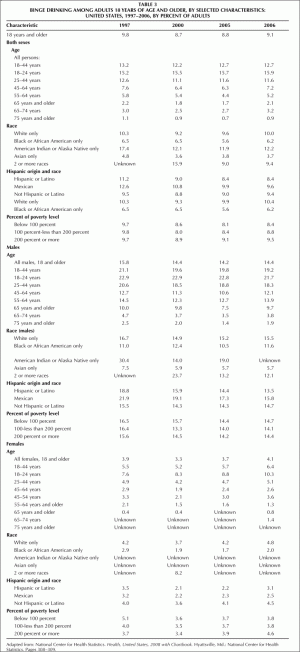Alcohol and Other Drugs: A Troublesome Combination
Another major problem among many people who are dependent on alcohol is that they are also dependent on another drug. The drug may be a stimulant, such as cocaine, or it could be a sedating drug such as benzodiazepine. (When used legally, benzodiazepines are antianxiety drugs.) The combination of illegal drugs or misused prescription drugs and alcohol is very dangerous and can be lethal.
Studies in Canada have shown that up to 30 percent of fatally injured drivers were using a combination of alcohol and drugs. A 2008 survey in Canada by Douglas J. Beirnes, published in 2009 by the Canadian Centre on Substance Abuse, found that 15.5 percent of drivers tested positive for alcohol, drugs, or both alcohol and drugs. The researchers found that alcohol use was most commonly found during weekends and late at night, while drug use was evenly distributed. Research in the United States and Canada has found that most drivers who abuse alcohol and drugs are males.
Moderate Drinking: A Health Boon to Some
Many studies have shown that moderate drinking, or the consumption of no more than one to two drinks per day, may confer a health benefit, particularly in terms of preserving healthy cardiac function. Other research shows that moderate drinking may be protective against the development of type 2 diabetes. Among people already diagnosed with diabetes, moderate drinking may provide a protective factor against heart disease as well; however, some studies show that moderate drinking may lead to hypoglycemia.
When health benefits are found with moderate drinking, these benefits are generally the most pronounced in middle-aged and older individuals, among whom moderate drinking may provide a protective benefit greater than abstinence offers.
However, if the moderate drinker escalates drinking to a higher level, the health benefits are lost.
Twenty-first Century Treatment Fortunately, enforced lobotomies and sterilizations and the other horrors of treatment for alcoholism are no longer lawful in the United States, and most people view them with horror. Today, hospitals, specialty clinics, and outpatient facilities treat individuals with alcohol dependence with medications such as naltrexone, acamprosate, and disulfiram, as well as with psychotherapy.
Table 3 -Binge Drinking Among Adults 18 years of age and older, by selected characteristics: United States, 1997-2006, by percent of adults Adapted from: National Center for Health Statistics. Health, United States, 2008 with Chartbook. Hyattsville, Md.: National Center for Health Statistics. Pages 308–309.
Adapted from: National Center for Health Statistics. Health, United States, 2008 with Chartbook. Hyattsville, Md.: National Center for Health Statistics. Pages 308–309.
Disulfiram, a drug used to induce aversion to alcohol, is still used today. This drug has an interesting history. It was first developed in 1947, when Danish researchers Erik Jacobsen and Jens Hald were testing it as a treatment to kill parasitic worms. They each tried the drug to see if it was toxic to them and did not notice any effects at all. However, later that day, the two researchers decided to go out and have a few drinks, and both quickly became extremely ill, with copious nausea and vomiting. After they recovered, Jacobsen and Hald realized that the drug might work far better as a treatment for alcoholism. (It is unknown if disulfiram works against parasites.)
However, compliance with a disulfiram regimen is notably poor, because the drug makes the user extremely ill even from a tiny amount of alcohol.
Medication compliance among alcoholics is also poor among medications such as naltrexone and acamprosate, which do not cause severe nausea.
Psychotherapy is another important form of treatment. Inpatient and outpatient facilities offer group and individual psychotherapy, as well as encourage individuals to attend frequent meetings of Alcoholics Anonymous. However, the broad majority of alcoholics refuse to seek any treatment whatsoever, failing to recognize that they have a problem and continuing to consume alcohol until it eventually takes its toll on their bodies with liver disease, cancer, pancreatitis, brain damage, and many other severe medical problems. Some people with alcohol dependence also suffer from degenerative mental diseases, such as Wernicke-Korsakoff syndrome, which leads to incurable dementia.
 Words That Have Been Used to Denote the Person Dependent on Alcohol
Words That Have Been Used to Denote the Person Dependent on Alcohol
Through the past few centuries in the United States, many words and phrases have been used, often pejoratively, to denote the person with alcohol dependence. Some key words and phrases are listed below. Some have fallen out of use (such as dipsomaniac or inebriate), while many are still used today, usually in a negative manner to convey contempt, such as drunk, drunkard, and sot. In general, the most judgmentfree term as of this writing is “person with alcohol dependence.”
alcohol addict
alcoholic
“alkie”
dipsomaniac
drunk
drunkard
drunken bum
drunken degenerate
drunken fool
habitual drinker
inebriate
person with alcohol dependence
problem drinker
Skid Row bum
sot
wino
###
Mark S. Gold, M.D. and Christine Adamec
###
REFERENCES
- Amethyst Initiative. Statement. Available online. Accessed March 1, 2009.
- Beirness, Douglas J., and Erin E. Beasley. Alcohol and Drug Use Among Drivers: British Columbia Roadside Survey, 2008. Ottawa, Ontario: Canadian Centre on Substance Abuse, 2009.
- Berridge, Virginia, and Sarah Mars. “History of Addictions.” Journal of Epidemiology and Public Health 58 (2003): 747–750.
- Blanco, Carlos, M.D., et al. “Mental Health of College Students and Their Non-College-Attending Peers: Results from the National Epidemiologic Study on Alcohol and Related Conditions.” Archives of General Psychiatry 65, no. 12 (2008): 1,429–1,437.
- Blocker, Jack S., Jr. “Did Prohibition Really Work: Alcohol Prohibition as a Public Health Innovation.” American Journal of Public Health 96, no. 2 (2006): 233–243.